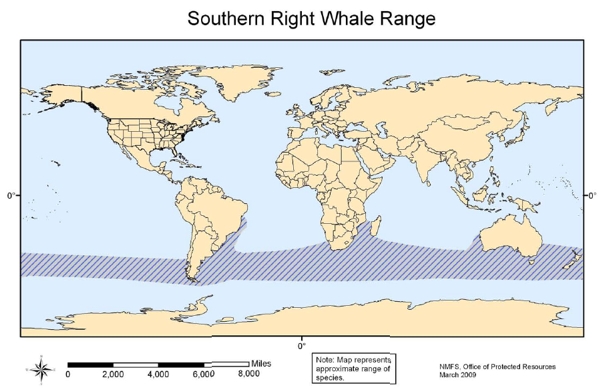

Destinations
Experiences
 |
L A
D A T C O T O U R
S |
 |
||||||||
| HOME | South America | Falkland Islands | Antarctica | Unique Destinations |
Unique Experiences |
Newsstand | ||||
About
|
About Peninsula Valdes |
EXCERPT FROM "RIGHT WHALES - FACT SHEET"
Jan 3, 2007 Written by Genevieve.Johnson
For complete fact sheet and to learn more, go to Whale TrackersRIGHT WHALE Fact Sheet
- Eubalaena australis (Southern right whale)
- Eubalaena glacialis (North Atlantic right whale)
- Eubalaena japonica (North Pacific right whale)
Class – Mammalia
Order – Cetacea
Suborder – Mysticeti
Family – Balaenidae
Genus – Eubalaena
Species – australis, glacialis, japonicaIntroduction
Right whales are one of 14 species of large whale. They belong to the sub-Order of baleen whales or Mysticetes that also includes, species such as the blue whale and the gray whale. Three right whale species are recognized in the genus Eubalaena, while the Bowhead Whale, its closet relative, is placed in its own genus, Balaena.Once abundant and globally distributed, right whales were the first and most heavily exploited whales. Although some populations are showing healthy signs of recovery, right whales are classified as endangered under the International Union for the Conservation of Nature (IUCN) red list, and the Convention for the International Trade in Endangered Species (CITES).
Right whales are large, bulky, baleen whales and are among the largest, and slowest swimming of all great whales. The right whales body is almost entirely black with irregular white patches on the abdomen. Unlike most other cetaceans, right whales have a broad, flat back that lacks a dorsal fin.
Physically mature females are larger than males; this is true of all baleen whale species. Adult right whales are an average 35-55feet (10.7-16.8 meters) long. Although the largest known individual measured over 60 feet (18 meters) in length and weighed 117 tons (9,106,500kg).
They may live at least as long as humans, and probably longer. For several months of the year, right whales frequent the coast, and as a result are a favorite species among whale watchers.
EXCERPT FROM NOAA FISHERIES: DISTRIBUTION OF SOUTHERN RIGHT WHALES
Read the complete article at NOAA Fisheries
 |
Distribution
Southern right whales occur throughout the southern hemisphere from temperate to polar latitudes (20° and 60° S. latitude). Within this range, they migrate between low-latitude winter breeding grounds and higher latitude feeding grounds. Southern right whales feed from spring to fall, and also in winter in certain areas. For much of the year, their distribution is strongly correlated to the distribution of their prey. The location of feeding grounds is not known with certainty but the IWC has identified the following areas:
- Brazil, False Banks, and Falkland Islands (30º - 50º S.)
- South Georgia and Shag Rocks (53º S.)
- Tristan da Cunha (40º S.)
- South of 50º S.
- Antarctic Peninsula (60 -70º S.)
The distribution of winter breeding, calving, and nursing grounds is known with greater certainty. Scientists have identified four major wintering areas:
- South Africa
- Argentina
- Australia
- sub-Antarctic New Zealand
In South Africa, right whales are predominantly found along the Cape coast between Muizenberg and Woody Cape. In Argentina, the major nursery and calving grounds are located along Península Valdés. In Australia, the main aggregations are found along the southern coasts of Western Australia, South Australia, and Tasmania. Within sub-Antarctic New Zealand, the two primary winter concentrations occur off the Auckland and Campbell Islands.